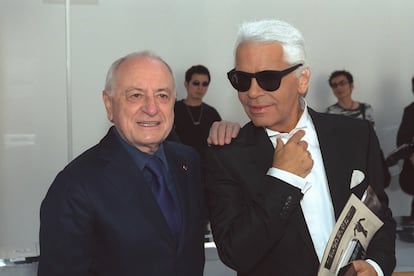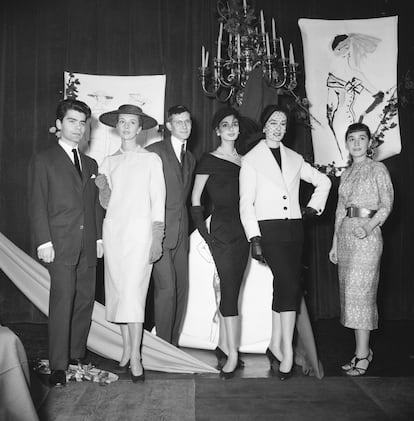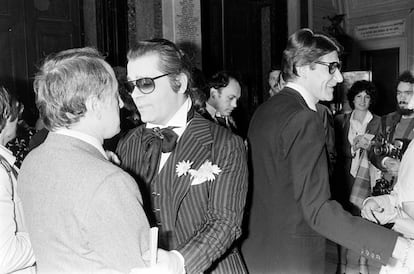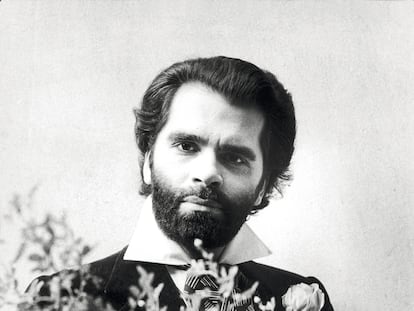Karl Lagerfeld and Pierre Bergé, the story of the ‘cruelest hatred’ in the world of fashion
The legendary designer and the businessman behind Yves Saint Laurent maintained a personal feud that would last for decades. On the occasion of the upcoming premiere of ‘Becoming Karl Lagerfeld’ — the miniseries about the German designer, which addresses this confrontation — EL PAÍS looks at the reasons for his staunch hatred of Bergé

The iconic fashion editor Suzy Menkes was the first person who dared to outline an epic rivalry. She established a simile about it, using one of the great (and frequently denied) historical legends of artistic envy: “Karl was Salieri going up against Mozart, who was Saint Laurent.” Exchanging the imperial Vienna of the 18th century for the Paris of the 1970s — and swapping out music for fashion — the truth is that the recent history of style cannot be understood without the well-documented antagonism between Karl Lagerfeld and Yves Saint Laurent. The two fashion geniuses crossed paths when they were almost teenagers: in 1954, they both shared first prize at the International Wool Secretariat (IWS). Although Lagerfeld — popularly known as “the Kaiser,” due to his German roots — maintained that they had been friends for a long time, the truth is that the dazzling success of the Algerian-born Saint Laurent starkly contrasted with Lagerfeld’s discreet beginnings. Each man had an ego as big as his own work, which helped separate their trajectories.
However, along with their differences, there’s one person who played a key role in creating distance between the two designers and whose influence had a big role on their respective lives. In the upcoming Hulu miniseries Becoming Karl Lagerfeld — which focuses on the designer who, for a time, was the creative director at Chanel — the figure of Pierre Bergé is revealed. For years, he was known as the “pitbull of French fashion.”
“Karl’s problem is the following: it’s like two starlets in the theater or cinema, when one becomes Marilyn Monroe and the other is a nobody. I like Karl a lot — I’ve known him forever. He’s really cultivated and very intelligent. Karl’s big problem is that he’s never been successful with his own label. And he hasn’t been able to reach the same level of success as under the name of Chanel. It’s sad,” Bergé told Vogue in 2015.
The man who was Saint Laurent’s right-hand man — co-founder of the eponymous brand and the designer’s romantic partner for decades — was never a friend of political correctness. The auditions to succeed Yves as creative director of his own firm offer evidence of Bergé's severity and dogmatism: after describing Tom Ford’s tenure as a “fiasco” and “pure marketing,” he went on to dismiss Stefano Pilati, calling his time at the fashion house “nothing at all.”
Bergé was lying when he said that he liked Karl. The antipathy between them was such that — according to the Kaiser himself — they went 40 years without speaking a word to each other. “He’s from another era,” Lagerfeld told WWD, in response to the accusations leveled against him by the businessman. “The times aren’t the same. He has to adapt to the times. The times don’t have to adapt to him. If he doesn’t like them, he should shut up and retire.”
Comparisons with Saint Laurent always gave Lagerfeld a complex. When he finally managed to succeed in the industry, he attacked him without remorse: “That particular Yves I don’t like, because I know another one. He’s one of the funniest people alive, with an incredible sense of humor… but he only had one desire: to be rich and famous.”

“Lagerfeld and Bergé started out as friends. They shared Bergé's love of books, but their relationship deteriorated over time. Bergé saw Yves Saint Laurent as an artist and a genius, but not Lagerfeld. And he made him feel that way. He also despised his German roots, in contrast to Yves’s French taste. Karl told me that he felt that his friendship with Yves had been destroyed by Bergé and that he probably played a role in his estrangement from him. For Bergé, there was only one place at the top of the pyramid… and it was for Yves,” explains Marie Ottavi, a journalist and biographer of Lagerfeld, in an interview with EL PAÍS.
The main reason for their enmity is a love triangle that Bergé never approved of, with the dandy Jacques de Bascher at the center of it. For two decades, this Parisian aristocrat maintained a platonic relationship with Lagerfeld, until his death from AIDS in 1989. They were two opposite personalities: while the couturier was a working man — a puritan who was allergic to parties — the enthralling De Bascher enjoyed alcohol, drugs, and orgies on a daily basis. “He was the funniest and most different person I’ve ever met. Wild, chic, and fun. He had all the flaws and all the qualities. For me, he was divine… but others found him diabolical,” the German designer alleged.
During one of those nights of hedonism and debauchery, De Bascher would meet Saint Laurent, a tormented genius who also made excess his way of life. This was much to the chagrin of Bergé, who broke off his romantic relationship with Yves when he found himself unable to “channel” the designer. In her book The Beautiful Fall, Alicia Drake wrote that Yves had a brief affair with Jacques de Bascher (with the full knowledge of a non-possessive Lagerfeld). And it was precisely Lagerfeld who realized that Bergé always thought that he had been the instigator behind the union of two souls with a tendency towards self-destruction. “I had been close friends with Yves for more than 20 years — Pierre smashed that to bits. He said I engineered their liaison to destabilize the house of Saint Laurent,” the German told W Magazine.

“The relationship between them was devastating, because Yves fell madly in love with Jacques. It had an impact on his work,” Ottavi adds, underlining the extreme vigilance that Bergé exercised over Yves’ excesses, so as to protect his textile empire. “If the romance had become serious, it could have disrupted the entire YSL [fashion] house, and also Bergé's authority. But the story was purely sexual. Although Bergé thought that Lagerfeld had orchestrated everything, seeing him as the organizer of the romance is going a bit far. He just found it amusing to see the chaos he caused,” Ottavi shrugs. Be that as it may, the friendly relationship between the creatives perished forever when De Bascher joined the equation.
This passionate episode will be one of the dramatic pillars of the Becoming Karl Lagerfeld series. Actor Daniel Brühl plays the Hamburg-born designer during the years he spent struggling to reach the top of haute couture and become head of Chanel. His relationships with Saint Laurent, De Bascher and Bergé — the axes of that professional journey — are also depicted.
Even after the death of the first two, Bergé and Lagerfeld didn’t bring an end to their long confrontation. “That their mutual hatred became public only accentuated the resentment between them. In my books, I describe the atrocities that were said… it was very cruel,” Ottavi notes. “Yves Saint Laurent was a pioneer and invented pieces that will go down in fashion history. Yet, his genius closed on him like a trap. Karl remained connected to the times: he reinvented himself and breathed new life into Chanel, that sleeping beauty that he managed to modernize. Each one had their own strengths…”
Sign up for our weekly newsletter to get more English-language news coverage from EL PAÍS USA Edition
Tu suscripción se está usando en otro dispositivo
¿Quieres añadir otro usuario a tu suscripción?
Si continúas leyendo en este dispositivo, no se podrá leer en el otro.
FlechaTu suscripción se está usando en otro dispositivo y solo puedes acceder a EL PAÍS desde un dispositivo a la vez.
Si quieres compartir tu cuenta, cambia tu suscripción a la modalidad Premium, así podrás añadir otro usuario. Cada uno accederá con su propia cuenta de email, lo que os permitirá personalizar vuestra experiencia en EL PAÍS.
¿Tienes una suscripción de empresa? Accede aquí para contratar más cuentas.
En el caso de no saber quién está usando tu cuenta, te recomendamos cambiar tu contraseña aquí.
Si decides continuar compartiendo tu cuenta, este mensaje se mostrará en tu dispositivo y en el de la otra persona que está usando tu cuenta de forma indefinida, afectando a tu experiencia de lectura. Puedes consultar aquí los términos y condiciones de la suscripción digital.
More information
Archived In
Últimas noticias
There is as much life left to discover on planet Earth as that which is already known
Dozens presumed dead, around 100 injured in fire at Swiss Alps bar during New Year’s celebration
Is porn for women different from conventional porn? We spoke to those who make it
Cartagena de Indias is sinking: What can the city do to mitigate it?
Most viewed
- Sinaloa Cartel war is taking its toll on Los Chapitos
- Reinhard Genzel, Nobel laureate in physics: ‘One-minute videos will never give you the truth’
- Oona Chaplin: ‘I told James Cameron that I was living in a treehouse and starting a permaculture project with a friend’
- David King, chemist: ‘There are scientists studying how to cool the planet; nobody should stop these experiments from happening’
- Why the price of coffee has skyrocketed: from Brazilian plantations to specialty coffee houses











































